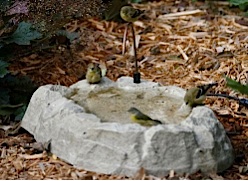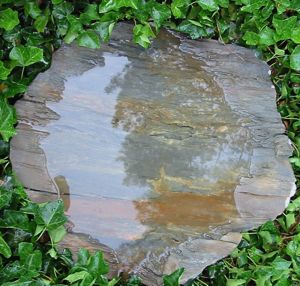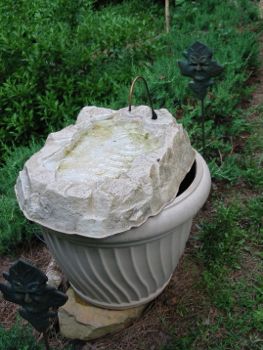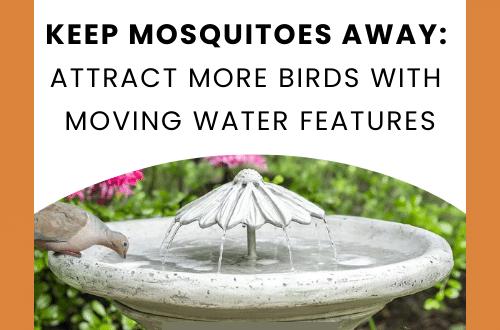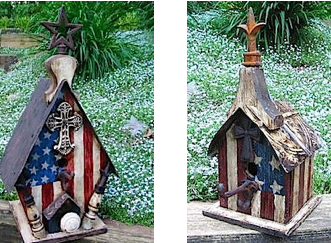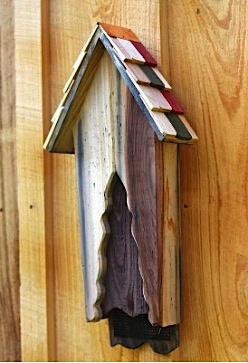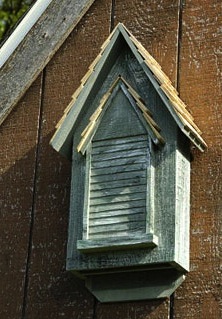-
The Neighbor’s Cat and Ground Bird Baths
The Rocky Mountain ground bath with dripper is pretty cool, birds actually sit and wait for it to start in the morning… but it no longer sits on the ground due to man-made predators 🙁
One of the oldest and most intense arguments… cats vs. birds and there’s basically two sides; birders and the people they refer to as “cat crazies”- those who let their cats roam because they believe it’s good for them. Ferals who roam are a problem for birds (but that stems from human ignorance too). Still, there are birders who are responsible cat owners and keep their feline friends indoors. We fit this category – four cats, whose outdoor time consists of a screened porch, and they’re pretty happy with the arrangement.
The neighbor “rescues” cats from the shelter, but they stay outdoors for the most part, which drives me bonkers! At times it’s infuriating, heated words have been exchanged on several occasions. The husband says “just shoot the cat”, but truth be told, I’d rather shoot the wife because it’s not the cats’ fault! Suggesting the cat sport a collar with a bell worked, but it really doesn’t help the birds too much.
A couple of cool ground bird baths are always in use around our yard, but they’re not on the ground anymore! This stinks because birds tend to bathe more naturally at this level. Enter tree stumps, large planters, small tables, and anything else that will add height to the bird baths. An excuse to add yet another, hanging style too.
The dripper birdbath now sits atop of a large planter, the big wood textured bird bath will look good on a tree stump, and the birds will definitely adjust in a day or two at most. Would’ve much rather kept things status quo, but it’s really not fair to the birds. Their lives needn’t be compromised due to the neighbor’s stupidity! And hey… one more hanging bath to maintain won’t make a big difference in the scheme of things… especially since we’re already known in the neighborhood as the crazy bird people 🙂
-
Americana Decorative Bird Houses
In honor of Memorial Day patriotic themes abound, everywhere is red, white and blue… and birdhouses too!
Reclaimed materials are used to craft these decorative birdhouses with vintage style. Hand made in Texas, Lorenzo Padilla creates original pieces using historic architectural elements and salvaged materials. Unique bird homes are reborn in these fine artworks, each is branded with his trademark emblem. Tin roofs and iron adornments pretty much started here about 20 years ago, widely copied by others today-but not the same!
Some of the siding and materials date back to the nineteenth century, sturdy woods rich in history that will withstand elements beautifully.
For nest clean-out, it’s fairly simple to back out 2 screws on the roof and gently lift the tin panel. Chickadees, wrens, titmice and other small songbirds will be happy to take up residence and call these places home.
.. a fine nest site and roost for cold nights too.
A few other decorative works for home and garden can be found. Tall cabinets with scroll front grates (which haven’t made it to the site yet) are absolute works of period art.
Although these houses are for the birds – most folks prefer to keep them as indoor decor!
Wishing all a Happy & Safe Memorial Day Holiday!
-
Attract Them and Offer Roosts with Bat Houses
They make some cool shelters these days, from vintage to Victorian, recycled plastic, even kits to build your own bat houses. You can try your luck at attracting bats without a big investment. But why would anyone want to attract them? One word – beneficial would sum it up best!
Bats are major pollinators and seed spreaders. Natural insect control is another huge advantage to hosting these friendly mammals (yes, they’re mammals). Even small bat colonies will consume thousands of mosquitoes and other pests nightly.
Habitat plays a key role in attracting any friendly fliers to your place. This holds true for butterflies, hummingbirds and songbirds too. If pesticides are being used, stop! They’re harmful to the to the environment, wildlife and the ecosystem in general. Pristine, manicured lawns are becoming passe, more naturalized areas are in style. This doesn’t mean jungle… it involves use of native plants, naturalized beds, and varied habitat.
You can attract bats by offering places for them to roost (other than your attic vents). Bat houses needn’t be plain square boxes, but stylish shelters that complement the landscape. The two shown are handcrafted in the USA, and made from solid cypress.
If water exists on your property, there’s a strong likelihood bats will use your shelters. Being near a creek, stream, or pond is preferable. They require a stable environment, steady temperatures within their roosts. Facing the houses south will allow full sun exposure to warm the boxes. Two bat houses are even better, facing them in different directions and allowing for varying temperatures. Leaving an outside light on at night may also assist in bringing bats to your place. As bugs swarm the light, bats will follow if they’re currently near your property.
Height is important when installing the houses as well. Some say 10 feet is sufficient, others claim 15-20 feet from the ground is best. Mount directly on a tree, structure or pole.
You can learn more about housing specs and hosting bats from The Organization for Bat Conservation.

